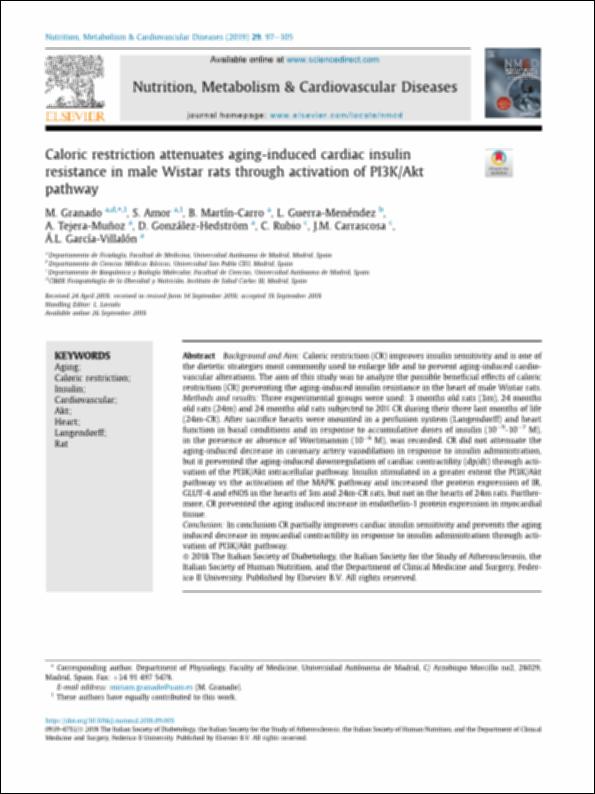Please use this identifier to cite or link to this item:
http://hdl.handle.net/10637/14981Caloric restriction attenuates aging-induced cardiac insulin resistance in male Wistar rats through activation of PI3K/Akt pathway

See/Open:
Caloric_Granado_et_al_Nutr_Metab_2018.pdf
Restricted Access
625,68 kB
Adobe PDF
Request a copy
| Title: | Caloric restriction attenuates aging-induced cardiac insulin resistance in male Wistar rats through activation of PI3K/Akt pathway |
| Authors : | Granado, Miriam Amor, Sara Martín-Carro, Beatriz Guerra Menéndez, Lucía Tejera Muñoz, Antonio González-Hedström, Daniel Rubio, C. Carrascosa, J. M. García-Villalón, Ángel Luis |
| Keywords: | Aging; Caloric restriction; Insulin; Cardiovascular; Akt; Heart; Langendorff; Rat |
| Publisher: | Elsevier |
| Citation: | Granado M, Amor S, Martín-Carro B, Guerra-Menéndez L, Tejera-Muñoz A, González-Hedström D, Rubio C, Carrascosa JM, García-Villalón ÁL. Caloric restriction attenuates aging-induced cardiac insulin resistance in male Wistar rats through activation of PI3K/Akt pathway. Nutr Metab Cardiovasc Dis. 2019 Jan;29(1):97-105. doi: 10.1016/j.numecd.2018.09.005. Epub 2018 Sep 26. PMID: 30497927. |
| Abstract: | Background and Aim: Caloric restriction (CR) improves insulin sensitivity and is one of the dietetic strategies most commonly used to enlarge life and to prevent aging-induced cardiovascular alterations. The aim of this study was to analyze the possible beneficial effects of caloric restriction (CR) preventing the aging-induced insulin resistance in the heart of male Wistar rats. Methods and results: Three experimental groups were used: 3 months old rats (3m), 24 months old rats (24m) and 24 months old rats subjected to 20% CR during their three last months of life (24m-CR). After sacrifice hearts were mounted in a perfusion system (Langendorff) and heart function in basal conditions and in response to accumulative doses of insulin (10 9-10 7 M), in the presence or absence of Wortmannin (10 6 M), was recorded. CR did not attenuate the aging-induced decrease in coronary artery vasodilation in response to insulin administration, but it prevented the aging-induced downregulation of cardiac contractility (dp/dt) through activation of the PI3K/Akt intracellular pathway. Insulin stimulated in a greater extent the PI3K/Akt pathway vs the activation of the MAPK pathway and increased the protein expression of IR, GLUT-4 and eNOS in the hearts of 3m and 24m-CR rats, but not in the hearts of 24m rats. Furthermore, CR prevented the aging induced increase in endothelin-1 protein expression in myocardial tissue. Conclusion: In conclusion CR partially improves cardiac insulin sensitivity and prevents the aging induced decrease in myocardial contractility in response to insulin administration through activation of PI3K/Akt pathway. |
| URI: | http://hdl.handle.net/10637/14981 |
| Rights : | http://creativecommons.org/licenses/by-nc-nd/4.0/deed.es |
| ISSN: | 1590-3729 |
| Issue Date: | Jan-2019 |
| Center : | Universidad San Pablo-CEU |
| Appears in Collections: | Medicina |
Items in DSpace are protected by copyright, with all rights reserved, unless otherwise indicated.

